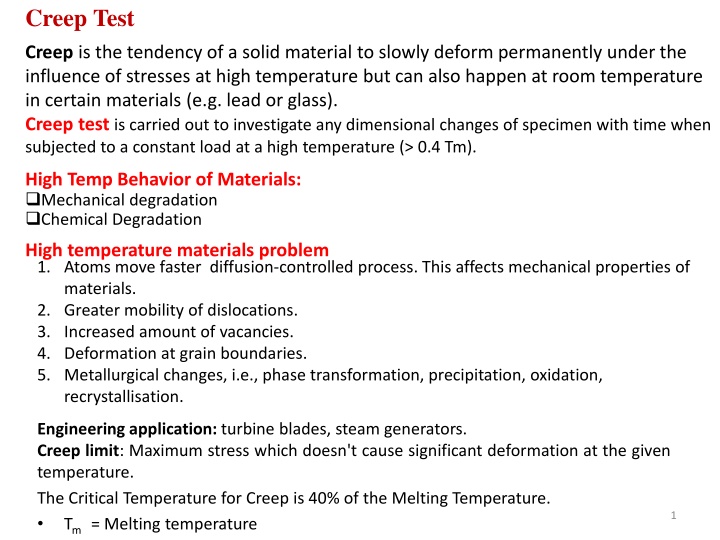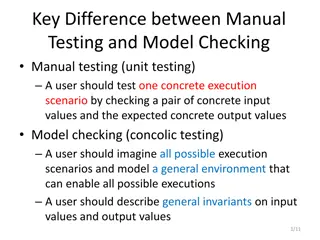
Understanding Creep Behavior in Solid Materials at High Temperatures
Creep is the tendency of solid materials to deform permanently under high temperature stresses. Creep tests are conducted to investigate dimensional changes under constant load at elevated temperatures. Learn about the stages of creep curve, factors affecting creep resistance, and high-temperature material behavior.
Download Presentation

Please find below an Image/Link to download the presentation.
The content on the website is provided AS IS for your information and personal use only. It may not be sold, licensed, or shared on other websites without obtaining consent from the author. If you encounter any issues during the download, it is possible that the publisher has removed the file from their server.
You are allowed to download the files provided on this website for personal or commercial use, subject to the condition that they are used lawfully. All files are the property of their respective owners.
The content on the website is provided AS IS for your information and personal use only. It may not be sold, licensed, or shared on other websites without obtaining consent from the author.
E N D
Presentation Transcript
Creep Test Creep is the tendency of a solid material to slowly deform permanently under the influence of stresses at high temperature but can also happen at room temperature in certain materials (e.g. lead or glass). Creep test is carried out to investigate any dimensional changes of specimen with time when subjected to a constant load at a high temperature (> 0.4 Tm). High Temp Behavior of Materials: Mechanical degradation Chemical Degradation High temperature materials problem 1. Atoms move faster diffusion-controlled process. This affects mechanical properties of materials. 2. Greater mobility of dislocations. 3. Increased amount of vacancies. 4. Deformation at grain boundaries. 5. Metallurgical changes, i.e., phase transformation, precipitation, oxidation, recrystallisation. Engineering application: turbine blades, steam generators. Creep limit: Maximum stress which doesn't cause significant deformation at the given temperature. The Critical Temperature for Creep is 40% of the Melting Temperature. Tm = Melting temperature 1
Figure 1: creep curves with stress and temperature effects So with Increasing stress or temperature: 1. The instantaneous strain increases 2. The steady-state creep rate increases 3. The time to rupture decreases 3
Stages of creep curve Most creep tests are conducted at constant load in analogous to engineering application, whereas creep tests at constant stress are necessary for understanding of mechanism of creep. Figure 2 shows a typical creep curve with three stages of creep. The slope of the creep curve is designated as creep rate. / t = / t (creep rate) s 0 Initial instantaneous strain o is instantaneous strain on loading which recoverable (anelastic) nonrecoverable (plastic). is partly time partly time with and with Figure 2: Typical creep curve 4
A typical creep curve shows three distinct stages with different creep rates. After an initial rapid elongation o, the creep rate decrease with time until reaching the steady state. 1) Primary creep stage is a period of transient creep and provides decreasing creep rate. The creep resistance of the material increases due to material deformation. 2) Secondary creep stage gives the representing constant creep rate and is believed to be due to balance between the competing processes of strain hardening and recovery. The minimum creep rate is the most important design parameter derived from the creep curve. It is the engineering design parameter that is considered for long-life applications. 3) Tertiary creep stage yields a rapid creep rate till failure. It is believed to occur because of either reduction in cross-sectional area due to necking or internal void formation. Third stage is often associated with metallurgical changes such as coarsening of precipitate particles, recrystallization, or diffusional changes in the phases that are present 5
Trancrystalline Creep Fracture Intercrystalline Creep fracture 7






















